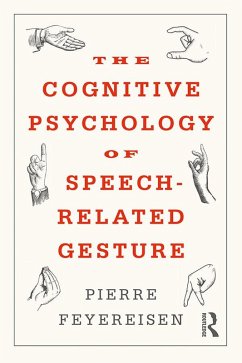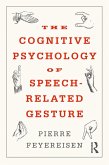The Cognitive Psychology of Speech-Related Gesture (eBook, ePUB)


Alle Infos zum eBook verschenken

The Cognitive Psychology of Speech-Related Gesture (eBook, ePUB)
- Format: ePub
- Merkliste
- Auf die Merkliste
- Bewerten Bewerten
- Teilen
- Produkt teilen
- Produkterinnerung
- Produkterinnerung

Hier können Sie sich einloggen

Bitte loggen Sie sich zunächst in Ihr Kundenkonto ein oder registrieren Sie sich bei bücher.de, um das eBook-Abo tolino select nutzen zu können.
Why do we gesture when we speak? The Cognitive Psychology of Speech-Related Gesture offers answers to this question while introducing readers to the huge interdisciplinary field of gesture. Drawing on ideas from cognitive psychology, this book highlights key debates in gesture research alongside advocating new approaches to conventional thinking.
Beginning with the definition of the notion of communication, this book explores experimental approaches to gesture production and comprehension, the possible gestural origin of language and its implication for brain organization, and the…mehr
- Geräte: eReader
- mit Kopierschutz
- eBook Hilfe
- Größe: 0.6MB
![The Cognitive Psychology of Speech-Related Gesture (eBook, PDF) The Cognitive Psychology of Speech-Related Gesture (eBook, PDF)]() Pierre FeyereisenThe Cognitive Psychology of Speech-Related Gesture (eBook, PDF)51,95 €
Pierre FeyereisenThe Cognitive Psychology of Speech-Related Gesture (eBook, PDF)51,95 €![Unusual Productions in Phonology (eBook, ePUB) Unusual Productions in Phonology (eBook, ePUB)]() Unusual Productions in Phonology (eBook, ePUB)33,95 €
Unusual Productions in Phonology (eBook, ePUB)33,95 €![Language and Gesture in Chinese Conversation (eBook, ePUB) Language and Gesture in Chinese Conversation (eBook, ePUB)]() Kawai ChuiLanguage and Gesture in Chinese Conversation (eBook, ePUB)39,95 €
Kawai ChuiLanguage and Gesture in Chinese Conversation (eBook, ePUB)39,95 €![Linguistic Morphology in the Mind and Brain (eBook, ePUB) Linguistic Morphology in the Mind and Brain (eBook, ePUB)]() Linguistic Morphology in the Mind and Brain (eBook, ePUB)39,95 €
Linguistic Morphology in the Mind and Brain (eBook, ePUB)39,95 €![International Handbook of Language Acquisition (eBook, ePUB) International Handbook of Language Acquisition (eBook, ePUB)]() International Handbook of Language Acquisition (eBook, ePUB)43,95 €
International Handbook of Language Acquisition (eBook, ePUB)43,95 €![Language and Cognition in Bilinguals and Multilinguals (eBook, ePUB) Language and Cognition in Bilinguals and Multilinguals (eBook, ePUB)]() Annette M. B. De GrootLanguage and Cognition in Bilinguals and Multilinguals (eBook, ePUB)48,95 €
Annette M. B. De GrootLanguage and Cognition in Bilinguals and Multilinguals (eBook, ePUB)48,95 €![Phonological Skills and Learning to Read (eBook, ePUB) Phonological Skills and Learning to Read (eBook, ePUB)]() Usha GoswamiPhonological Skills and Learning to Read (eBook, ePUB)46,95 €
Usha GoswamiPhonological Skills and Learning to Read (eBook, ePUB)46,95 €-
-
-
Beginning with the definition of the notion of communication, this book explores experimental approaches to gesture production and comprehension, the possible gestural origin of language and its implication for brain organization, and the development of gestural communication from infancy to childhood. Through these discussions the author presents the idea that speech-related gestures are not just peripheral phenomena, but rather a key function of the cognitive architecture, and should consequently be studied alongside traditional concepts in cognitive psychology.
The Cognitive Psychology of Speech Related Gesture offers a broad overview which will be essential reading for all students of gesture research and language, as well as speech therapists, teachers and communication practitioners. It will also be of interest to anybody who is curious about why we move our bodies when we talk.
Dieser Download kann aus rechtlichen Gründen nur mit Rechnungsadresse in A, B, BG, CY, CZ, D, DK, EW, E, FIN, F, GR, HR, H, IRL, I, LT, L, LR, M, NL, PL, P, R, S, SLO, SK ausgeliefert werden.
- Produktdetails
- Verlag: Taylor & Francis eBooks
- Seitenzahl: 234
- Erscheinungstermin: 28. Juli 2017
- Englisch
- ISBN-13: 9781351788274
- Artikelnr.: 48959078
- Verlag: Taylor & Francis eBooks
- Seitenzahl: 234
- Erscheinungstermin: 28. Juli 2017
- Englisch
- ISBN-13: 9781351788274
- Artikelnr.: 48959078
- Herstellerkennzeichnung Die Herstellerinformationen sind derzeit nicht verfügbar.
gestural communication about?. Gestures, actions, movements, signs.
Analyses of communication: codes, inferences, social influences. Why are
cognitive psychologists interested in gestural communication? The diversity
of disciplines. Cognitive approaches: the nature of thought. Mental
mechanisms. Research questions - Plan. 2. Speaking hands: inventory of
forms and functions. Pioneers. Wilhelm Wundt (1900): gestures as mental
representations. David Efron (1941): discourse marking by hand movements.
Nonverbal behaviour, a wide-ranging topic. Current perspectives.
Gesticulation and autonomous gestures: break or continuity? Gestures of
monologue and dialogue. Gesture infancy. Gesture impairments in case of
brain damages. Beyond "chirocentrism" 3. Ghosts in the machine : models of
gesture processing. Translucent architectures: gestures reveal thought.
Adam Kendon and the ethnography of communicative action. Susan
Goldin-Meadow: gesture as a window on the mind. Information processing
models. Dynamical models. Pragmatic approaches. Conclusions 4. Production
mechanisms. Do the speakers take perspective of their addressee when they
gesture? Social context. Common ground. Why do some spoken utterances
involve gestures whereas others do not? Activation of visuo-spatial and
motor imagery. Problems in lexical access and in conceptualization.
Performing gestures or not: effects on speech production. How do spoken and
gestural production co-operate? Physical characteristics of oral and manual
movements. Temporal relationships between gestures and speech. Conclusions:
cooperative or competitive relationships? 5. The impact of gestures on
speech comprehension. Is message comprehension influenced by the gestures
of the speaker? How visual and auditory information is integrated in verbal
comprehension? Electrophysiological approaches. 6. Evolution and
neuropsychology of gestures. Does human speech stem out manual skills? Does
gestures and speech involve the same brain regions? Manual preferences in
speech-related gestures. Gesture use by persons suffering from brain
lesions. Neuroimagery of gestural communication. 7. The development of
gestural communication. How do babies learn to read minds and to
communicate their intentions? What is the role of gestures in language
acquisition? Gesture use and atypical language development. 8. Final
remarks
gestural communication about?. Gestures, actions, movements, signs.
Analyses of communication: codes, inferences, social influences. Why are
cognitive psychologists interested in gestural communication? The diversity
of disciplines. Cognitive approaches: the nature of thought. Mental
mechanisms. Research questions - Plan. 2. Speaking hands: inventory of
forms and functions. Pioneers. Wilhelm Wundt (1900): gestures as mental
representations. David Efron (1941): discourse marking by hand movements.
Nonverbal behaviour, a wide-ranging topic. Current perspectives.
Gesticulation and autonomous gestures: break or continuity? Gestures of
monologue and dialogue. Gesture infancy. Gesture impairments in case of
brain damages. Beyond "chirocentrism" 3. Ghosts in the machine : models of
gesture processing. Translucent architectures: gestures reveal thought.
Adam Kendon and the ethnography of communicative action. Susan
Goldin-Meadow: gesture as a window on the mind. Information processing
models. Dynamical models. Pragmatic approaches. Conclusions 4. Production
mechanisms. Do the speakers take perspective of their addressee when they
gesture? Social context. Common ground. Why do some spoken utterances
involve gestures whereas others do not? Activation of visuo-spatial and
motor imagery. Problems in lexical access and in conceptualization.
Performing gestures or not: effects on speech production. How do spoken and
gestural production co-operate? Physical characteristics of oral and manual
movements. Temporal relationships between gestures and speech. Conclusions:
cooperative or competitive relationships? 5. The impact of gestures on
speech comprehension. Is message comprehension influenced by the gestures
of the speaker? How visual and auditory information is integrated in verbal
comprehension? Electrophysiological approaches. 6. Evolution and
neuropsychology of gestures. Does human speech stem out manual skills? Does
gestures and speech involve the same brain regions? Manual preferences in
speech-related gestures. Gesture use by persons suffering from brain
lesions. Neuroimagery of gestural communication. 7. The development of
gestural communication. How do babies learn to read minds and to
communicate their intentions? What is the role of gestures in language
acquisition? Gesture use and atypical language development. 8. Final
remarks







